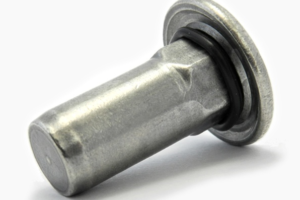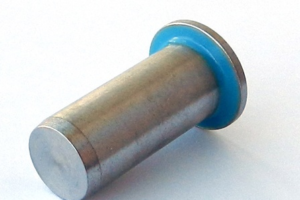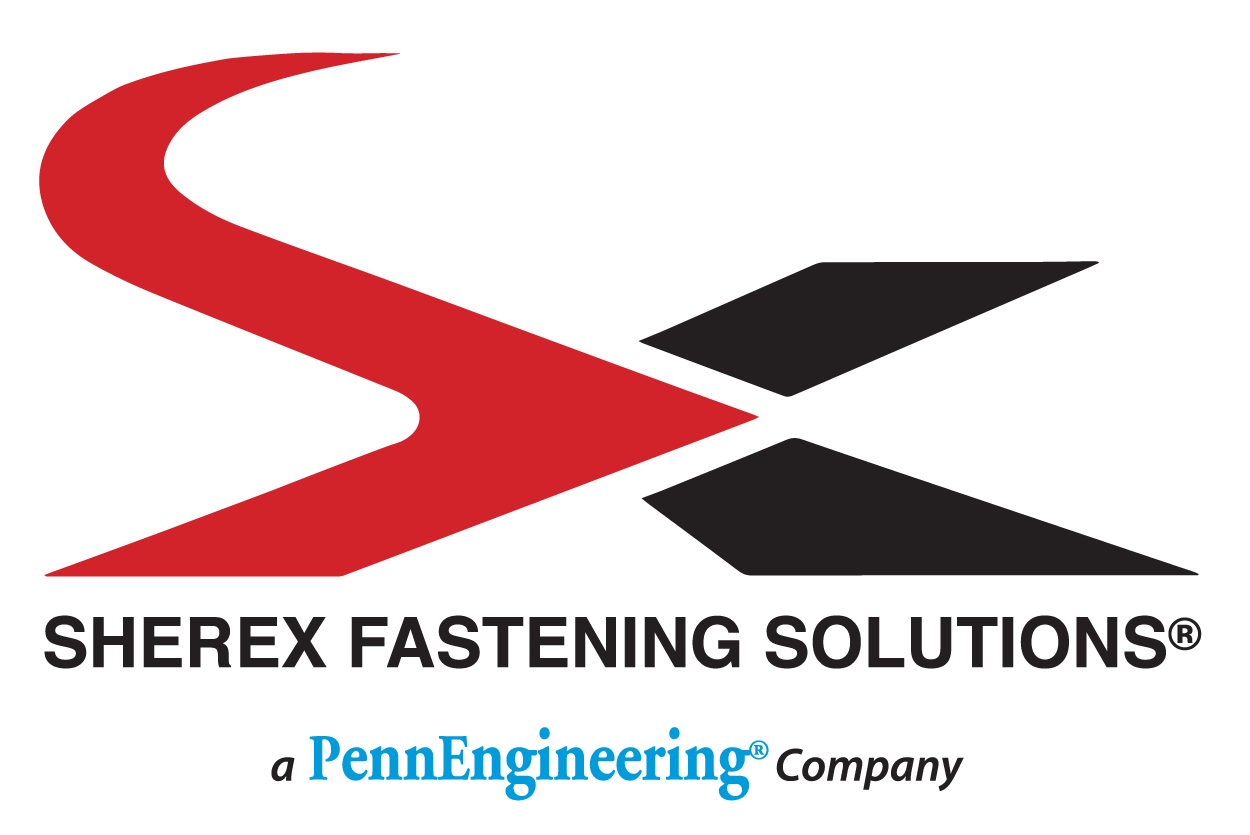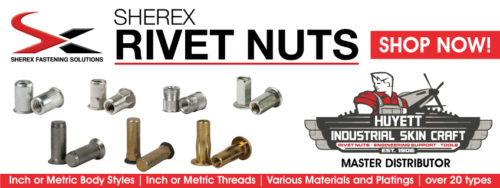Watertight Rivet Nuts
2 CommentsIn an earlier post we talked about how corrosion should be considered when choosing the type of rivet nut to use in your next project, and what types of sprays can help deter or limit the pace of red rust and white rust from occurring.
Now water will certainly speed up the corrosion process, but that shouldn’t eliminate the use of rivet nuts in wet conditions, or conditions where a rivet nut will spend some of its life submerged in water or fluid.
Our partner Tubtara® has a few different watertight and fluid proof rivet nuts that are designed with seals underneath the flange to keep water and fluids from leaking through the rivet nut. Tubtara’s Watertight HX series feature a O-ring seal mounted underneath the flange, and provides protection against moisture, oil, and dirt under high pressures. Despite the O-ring, it will deliver a metal to metal contact after installation.

Tubtara Watertight HX Rivet Nut. Notice the O-ring seal underneath the flange.
The Watertight (H)DPX Series is a rivet nut that has an applied sealant underneath the head. This non-reactive seal is resistant to many auto oils, antifreeze and other kinds of fluids with a higher viscosity. The seal in the (H)DPX Series can come in a variety of different seal material including NBR, Viton, silicone, epoxy based, acrylate and polyurethane resin.

Non-reactive seal is great for use in high viscosity fluids
Any application where you wouldn’t want water or fluid to leak underneath or through the rivet nut should require a watertight rivet nut. Without using one of the seals, whether it’s an O-ring or sealant, it may not be completely watertight – especially as corrosion begins to develop.
For more information on watertight rivet nuts, or if looking for a solution for fasteners that will perform well under water or fluid, contact us!
Sherex tabs G.L. Huyett as Master Distributor
Leave a CommentSherex’s full line of standard rivet nuts, wedge locking washers and tooling and installation systems are available now with fast shipping on G.L. Huyett’s website.
With a 100-plus year history, great customer service, fast shipping, and low line minimums, G.L. Huyett was an ideal choice as master distributor for Sherex in the Midwest United States.
“G.L. Huyett added the Disc-Lock wedge-locking washer product line to their portfolio in 2018 and we’ve been so impressed with their support to the market that we decided to expand the relationship to include the full line of Sherex rivet nuts and hand tools,” said Adam Pratt, president, Sherex Fastening Solutions. “They understand our product, have outstanding customer service, and are very reliable in terms of shipping and having product readily available.”
G.L. Huyett will help support Sherex with safety stock and small quantity orders, along with technical and engineering support. It’s a win-win situation.
“We have shared significant resources so that our sales and engineering teams can not only support the market with safety stock and small quantity fulfillment, but also in design-in and business development actions with our OEM fastener distributor customers,” said Tim O’Keeffe, CEO, G.L. Huyett, in a 2019 press release. “We will be a great team out there.”
Visit huyett.com to see Sherex’s full line of products readily available for immediate shipment.
Spin-Spin vs. Spin-Pull Rivet Nut Tooling
Leave a CommentWhen it comes to rivet nut tooling, there are a variety of different options. While small-volume applications may often result in a manual hand tool being the best choice, larger-volume installation projects may require more robust tooling. Two of the most popular non-manual options are air-powered tools that install rivet nuts through either a spin-spin and spin-pull action.
Let’s go through the differences between spin-spin and spin-pull rivet nut installation tools.
Spin-Spin Rivet Nut Tool
A spin-spin rivet nut tool is an air-powered tool that, once a rivet nut is secured onto it, utilizes torque to spin its mandrel inward in order to collapse the rivet nut. The torque, driven by an air motor, ramps up continuously until the rivet nut fully collapses. After installation, the tool’s reverse trigger must be pressed to separate the tool from the now-installed rivet nut. In order to both maintain tool integrity as well as ensure proper installations, it is recommended that spin-spin mandrels be lubricated with wax.
The benefit of using spin-spin tools is that they are less expensive than spin-pull and can often be more lightweight, but its capabilities aren’t as complete as the spin-pull tool.
The installation base material can vary in thickness, but it is recommended that the rivet nuts being installed are thin-walled steel, aluminum or brass. Also, depending on what kind of spin-spin tool you purchase, it may often be limited in the thread sizes it can install. For instance, Sherex’s SSG-802 spin-spin tool is capable of installing parts with #10, ¼”, M5, and M6-diameter threads, and the SSG-803 is capable of installing 5/16”, 3/8”, M8, and M10-diameter threads. A hydro-pneumatic spin-pull tool is capable of installing all sizes between M3 to M10.
For a job that is consistently is going to use one part and one size, a spin-spin rivet nut tool would be a solid recommendation for the price.
Spin-Pull Rivet Nut Tool
A spin-pull rivet nut tool installs rivet nuts by pulling back its mandrel, rather than spinning it back. The rivet nut spins itself on to the mandrel, and then the mandrel pulls the threads of the rivet nut on to the base material, installing the rivet nut. The tool then spins the opposite way to release installed rivet nut. This tool is also referred to spin-pull-spin as explained in the two sentences before.
Sherex’s Flex-5 line of spin-pull tools is hydro-pneumatic, as the tool uses air and oil to install the part. A spin-pull tool can install everything that a spin-spin tool can, as well as more heavy-duty rivet nuts like full-body hex-style rivet nuts, European body styles, and stainless steel parts.
Another benefit of using a spin-pull tool is that it can install a wide range of thread sizes – from M3 through M10 for metric sizes, and from #4-40 to 3/8”-24 for inch sizes. You would need three different spin-spin tools to install that thread range!
For a job that is consistently is going to use one (compatible) part at one size, a spin-spin rivet nut tool would be a solid recommendation for the price. A spin-spin tool may be heavier and more expensive, but it is a far more versatile tool that can install more styles and more sizes of rivet nuts. All that is needed – for either tool – is the appropriate headset for the thread size you are trying to install.
Need help deciding between a spin-spin tool and a spin-pull tool for your next project? Contact us!






